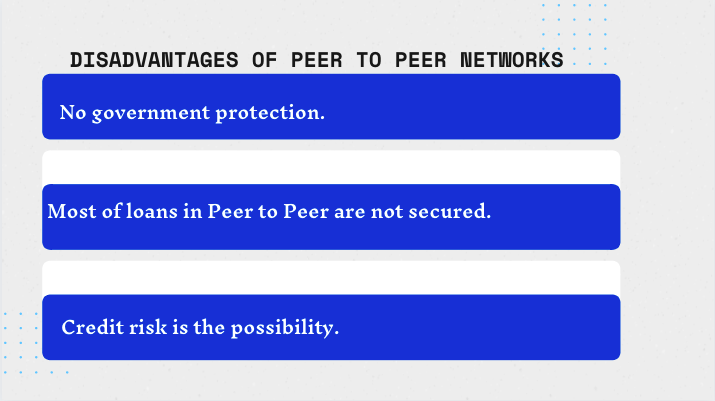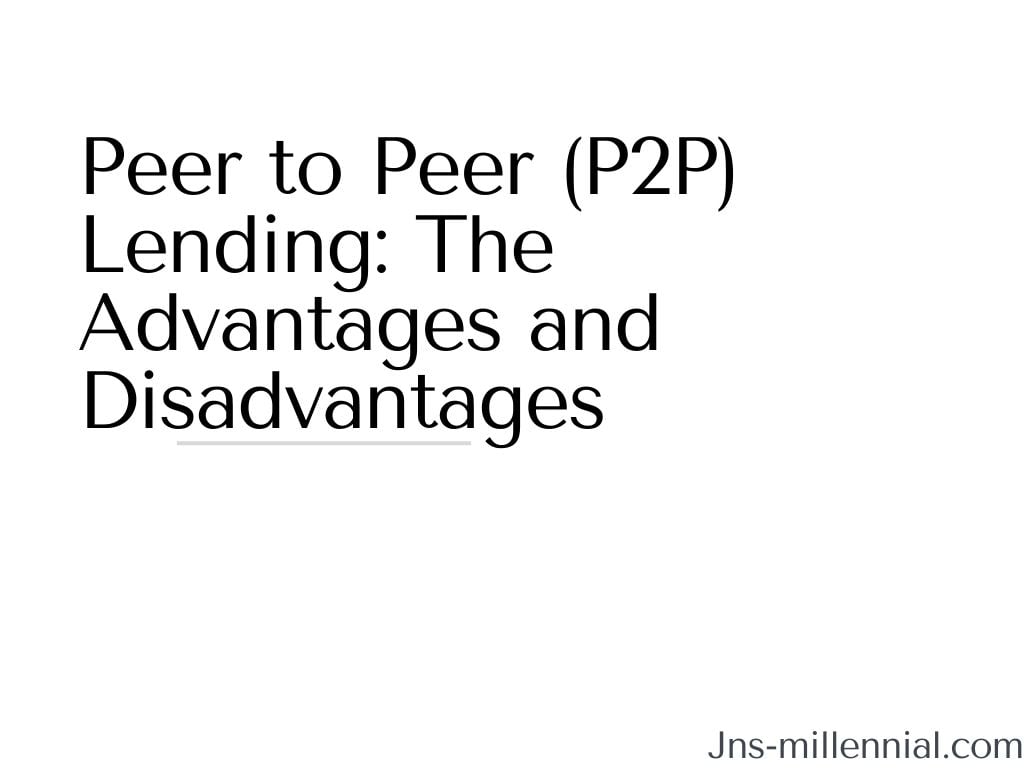Peer to Peer (P2P) Lending: The Advantages and Disadvantages
This article has links and images regarding the suggestions that we may receive a commission if click to purchase.
Before making any financial investment regarding Peer to peer loans or lending, investors must ensure to get familiar with the way how the investing system works in order to determine whether peer-to-peer lending aligns with their investment goals and needs.
In this article, the following phenomenon aspects regarding peer-to-peer lending (P2P) will explain in detail the terms, how it works, and the pros and cons of peer-to-peer lending, which provide our readers the general knowledge to consider before making any investment decision.
What is Peer Peer lending (P2P)?
How Does Peer to-Peer Lending Work?
Is Peer-to-Peer Lending Safe?
The best Peer to Peer lending Platform in The market
Peer To Peer Lending (P2P) Pros and Cons
Key Takeaways
Table of Contents
- Peer to Peer lending allows both lenders and borrowers to come to make an agreement by using the online lending platform.
- Most of the loans from P2P lending are not 100% secured- it contains a high level of risk.
- It generates a higher return on investment due to a higher interest rate.
Read next: Financial Tips: Simple Ways to Start Saving Money in 2021
1. What is Peer to Peer Lending (P2P)?
Peer-to-peer lending (P2P) is the investment system, where it allows individuals to use the system and lend money directly to other businesses, and individuals. In other words, those lenders and borrowers use peer-to-peer networks to make a deal directly with each other, and they don’t need any financial institutions to act as a third party for making a financial investment deal. Hence, it allows them to avoid paying the fees for the middleman or third party.
In addition, individuals who borrow money from peer-to-peer networks, which require to pay the loan back with interest fees. Peer-to-peer lending is normally approved via online financial platforms that allow lenders and borrowers to come to a financial agreement.
Importantly, P2P lending is considered an alternative method of financing- a type of investment vehicle to create a passive income source for investors. However, most of the commercial loans in P2P lending are not safe and unsecured. The risk levels of loans will be determined based on borrowers’ credit risks and the industry they operate.
Read next: 6 Must-have Tools To Support Freelance Writers
2. How Does Peer-to-Peer Lending Work?
As mentioned before, most of the commercial loans in P2P lending are done by using a financial platform that matches the lenders and borrowers in order for them to strike a deal. The following step-by-step guides explaining on how does peer to peer lending works
- Businesses or individuals who wish to obtain a loan in P2P networks require to complete an online application form on one of the chosen financial platform, which allow the P2P platform to determine the credit risk level of borrowers.
- Once the borrowers’ credit rating is checked, they need to read the term and conditions regarding the lending interest rate and payment date upon signing a contract for approval.
- P2P online lending platform will offer several lenders to borrowers based on their credit rating.
- After the P2P lending deal is matched, borrowers have the obligation to pay back the loan with interest fees on the due date.
There are the complete steps to help you understand how the peer-to-peer lending system works. consider understanding the type of investment before making a decision is a must because it helps to avoid any unnecessary disputes or issues in the future.
Notes, both borrowers and lenders are required to pay small interest fees to the online peer-to-peer lending platform.
Read next: Best Investment Apps in 2022
3. Is Peer-to-Peer Lending Safe?
Similar to other investment vehicles like stocks and real estate investing, P2P lending has a high degree of risk due to the fact there is no government protection or legislation for both lenders and borrowers. In addition, most of the loans in peer-to-peer lending are not safe as it depends on the ability to pay back by the borrowers and their credit rating.
In particular, borrowers with a high credit risk might choose peer-to-peer lending as an alternative way to obtain a loan because those people normally got turned down by banks or other financial institutions about their loan approval.
Read next: How to Decrease Student Loan Debt
4. Peer to Peer lending Platforms in The market
Peer-to-peer lending platforms allow the borrowers and lenders to come to a financial agreement together. In particular, the platform will run a credit check on a borrower and determine the interest rate based on their credit rating. After that, they will match borrowers and lenders to create a contract.
Notes: the platform will charge a service fee to both lenders and borrowers for providing a service.
There are a number of P2P lending platforms in the market, which act as a gateway for both lenders and borrowers to come to make an agreement such as Upstart, Payoff, Prosper, and Peerform, just to name a few.
Importantly, you must perform research on a particular P2P lending platform in order to have an overview picture of how good the platform is. Consider searching a few peer-to-peer platforms, which allow you to make a better decision.
5. Peer To Peer Lending (P2P) Pros and Cons

The last section of this article is the critical one about peer-to-peer lending, in which you can determine whether peer-to-peer lending is the right investment vehicle for you.
Advantages
- Higher interest rate compared to other high yield saving accounts such as CD or high saving accounts. In other words, it provides a better return on your investment than saving money in the bank.
- It is easy to make a deal with the borrowers due to the fact that the P2P lending platforms assist both lenders and borrowers by matching them together in accordance with the borrower’s credit rating. In other words, it is easily accessible for lenders to make money as a passive income.
Disadvantages
- In terms of credit risk, peer-to-peer lending is not safe because the platforms may not provide enough information about the high-risk exposure of the borrowers. For this reason, from an investor’s point of view, you might lose all of your money from the investment.
- There is no government protection for lenders in case the borrowers stop paying money pay to the lenders. In particular, if lenders got scammed due to fraud or platform errors, they will have no other option but to claim compensation.
- The high risk of Borrowers having financial difficulties is the worse outcome that most lenders must reconsider before making any investment. For instance, borrowers may apply for a financial hardship due to illness or loss of their full-time job, which means lenders must accept to renegotiate the payment date with a lower interest fee.
- There is no insurance protection in case lenders are having an issue with borrowers in terms of payment and interest fees. You have no option to make compensation or seek protection from insurance.
Conclusion
Overall, peer-to-peer lending is considered an alternative method of financing, which allows lenders to generate other passive income sources. However, like most other investment vehicles, the lender must understand their exposure to the high level of risk due to the fact there is no guarantee of insurance, government, and borrower ability to pay.
For this reason, investors must ensure to understand the way how the investing system works in order to determine whether peer-to-peer lending aligns with their investment goals and needs.
Read next: The 6 Best Personal Finance Books in 2022
By Jiro Nguyen, Founder of JN-Solutions parent site of- Jns-millennial.com
The content is based on the personal opinion of the author. It is accurate and true based on the best knowledge of the author and his research. Content is for entertainment and informational purposes only and we are not financial advisors, personal counselors, or other professional advisors. It should not be used as comprehensive or a substitute for professional advice.
